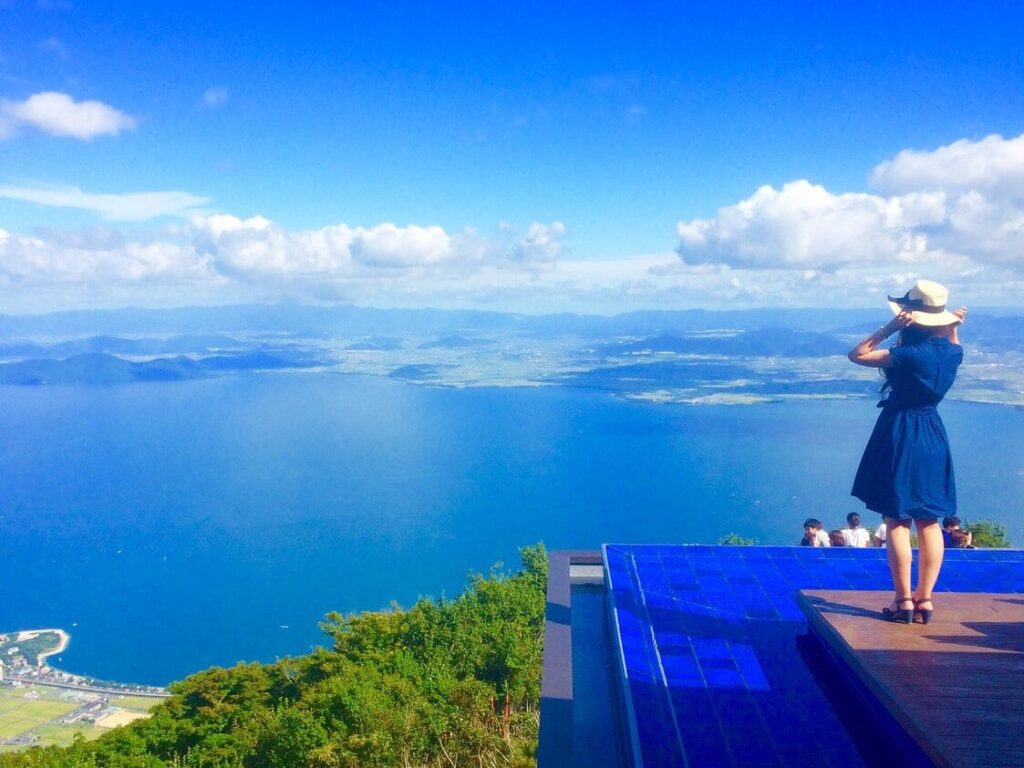
♭♯♭琵琶湖就航の歌♭♯♭
The summer scenery viewed from Mount Horai, which stands majestically on the western shore of Lake Biwa, is both grand and evokes various thoughts as a primeval landscape. The origin of the name “Lake Biwa” is said to be first recorded in a book left by Kousou, a scholar monk from Mount Hiei, in the early 16th century. It is believed that he observed the lake spreading out below daily and imagined its shape resembling the musical instrument “biwa” (a type of lute). Given that it was a time when aerial views were not possible, this shows an astonishing level of insight.
Lake Biwa, which occupies one-sixth of the area of Shiga Prefecture, is of course a freshwater lake, but ancient people probably thought it was a sea and called it “淡海” (Awumi, meaning freshwater sea), which later became the origin of the name “Omi”. Emperor Tenji opened the capital of Otsu because of the presence of this lake. After the Yamato court suffered a major defeat at the Battle of Baekgang while supporting its ally Baekje, it relocated the capital from Asuka to Otsu to prepare for potential invasions from Tang and Silla. Otsu seemed attractive because it was protected by Mount Hiei to the west and had an easy escape route via Lake Biwa to the east. However, the capital only existed in Otsu for five years and five months.
The relocation of the capital originally displeased the aristocracy, and after Emperor Tenji’s death in 671, a succession struggle known as the Jinshin War broke out in 672 between Emperor Tenji’s son, Prince Otomo, and his brother, Prince Oama. Prince Oama emerged victorious, ascended the throne as Emperor Tenmu, and moved the capital back to Asuka, constructing the Asuka Kiyomihara Palace. Later, Oda Nobunaga built Azuchi Castle on the shore of Lake Biwa, boasting the tallest wooden structure in Japan at the time, commanding control over the land. However, following the Incident at Honnoji, it too was destroyed just six years later.
琵琶湖西岸に屹立する蓬莱山から見下ろす夏景色は雄大でもあり、様々な思いを想起させる原風景でもあります。そもそも琵琶湖の名前の由来は、16世紀の初頭、比叡山の学僧光宋が残した書籍に記されているのが最初だといわれています。おそらく眼下に広がる湖を日々眺望して、楽器の琵琶から湖の形状を想像したものと思われます。上空から見ることのできない時代に、恐るべき洞察力といえます。
滋賀県の面積の6分の1を占める琵琶湖はもちろん淡水ですが、おそらく古代の人達は海だと思ったでしょうから淡海と呼び、後の近江の由来にもなりました。天智天皇が大津京を開いたのもこの琵琶湖があったからです。同盟国百済を支援して白村江で大敗した大和朝廷は、唐・新羅の侵攻に備えて、それまでの飛香京から遥か離れた大津京に遷都しました。西は比叡山に守られ、また東の琵琶湖に逃げやすい大津の地が魅力的に見えたからです。しかし、大津に都が存在したのはたったの5年5か月でした。
元々この遷都には貴族達の不興を買っていたこともあり、671年に天智天皇が崩御すると、翌672年には天智天皇の息子・大友皇子と弟・大海人皇子の後継争い「壬申の乱」が勃発し、争いに勝利した大海人皇子は、再び元の飛鳥の地に飛鳥浄御原宮を造営し、天武天皇として即位しました。その後も、織田信長が琵琶湖のほとり、安土に当時の木造高層建築で日本一の天主を誇っていた安土城を築き、天下に号令しますが、本能寺の変を経て、これもまた僅か6年後に焼失しました。
